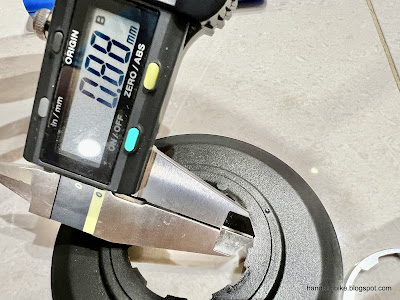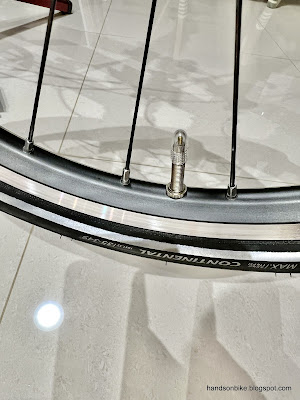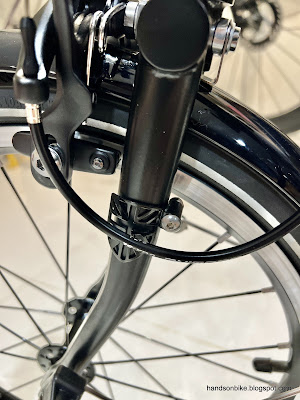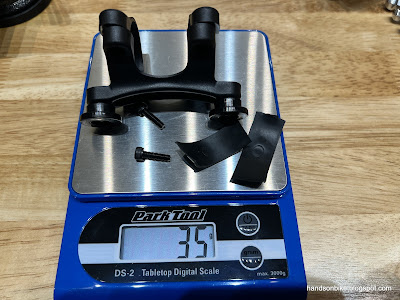Although the Brompton P Line uses a titanium front fork and rear triangle to save weight over the regular C Line (similar to old M6R that I had), those are probably not the only areas where weight reduction can be found.
From my experience, there can be quite a lot of weight savings to be found from the wheelset and also the tires mounted on it. At the same time, I was curious about the 4 speed components used on the P Line, and wanted to take a closer look at them.
Most importantly, I didn't like the Schrader inner tube valves that came with the bike. All my other bikes use Presta valves, while my Lezyne Sport Gravel Floor Drive only has Presta pump head. Therefore it makes sense to have all my bikes use the same type of valves to avoid having to switch pump heads or use adapters. This means I need to change the inner tubes on the P Line to the Presta valve type, which will involve disassembling both wheels from the bike.
After removing the front quick release axle, a steel plate can be seen holding onto the hub axle. This is a secondary feature which prevents the wheel from falling out of the dropout if the quick release axle comes loose.
This axle retaining plate is not commonly seen on other front forks of other bikes, as the more common design is to have a raised lip to perform the same function.
The reason Brompton uses this design with an additional part is to balance the other side of the front fork, where there is a steel bracket to support the front hook.
Steel bracket with dual function: Prevent hub axle from falling out, and also to hold the bent steel wire bracket of the front hook.
Next, I removed the tires from the wheelset, as I wanted to check some specifications of the rims. The lightest 16" wheelset that I have used was on the United Trifold, where I upgraded the stock internal hub wheelset to the super lightweight Elosix wheelset which weighs only 951 grams!
Brompton P Line rim internal width is about 17.6 mm, which is a decent width and not too narrow.
For some reason I forgot to measure the external rim width and rim height, but I guess those can be measured easily without dismantling anything.
Tire weight is 220 grams which is decent as well, although not as light as the Schwalbe One which is just 174 grams each.
Stock butyl inner tube weighs 87 grams. I could save at least 50 grams per wheel by using lightweight TPU inner tubes, but the frequent tire pressure top up is not worth the hassle in this case.
New Schwalbe butyl inner tubes, which is slightly lighter at 82 grams each. They are of the Presta valve type which is my whole objective of changing out the inner tubes.
With the front wheel done, I moved on to disassemble the rear wheel. This is where it gets more interesting, with the 4 speed external drivetrain to be studied in more detail.
Rear derailleur hanger is made of aluminium, and looks well designed and made.
Removing the rear wheel is tricky, as it involves sliding the rear hub axle rearwards, where it is being blocked by the rear mudguards.
4 steel sprockets of sizes 11-13-15-18T, and secured by a Sunrace lockring.
The 4 sprockets with spacers plus lockring weighs 81 grams.
There is a plastic spoke guard at the back of the largest sprocket, to prevent the chain from going into the spokes if the rear derailleur low limit is not set correctly.
There is a 2 mm cassette spacer behind the largest sprocket as well. Different from the usual 1.85 mm spacer found on some Shimano cassettes.
The plastic spoke guard itself has a thickness of about 0.9 mm. This means there is additional 2.9 mm of space behind the largest sprocket in stock condition.
Stock rear quick release axle weighs 35 grams. It is basically an extra long bolt with a nut at the end, so technically not quick release as an Allen Key is required.
Front wheel weighs 447 grams, about 50 grams more than the super lightweight Elosix front wheel.
Rear wheel with the short freehub body weighs 628 grams, about 70 grams more than the Elosix version with full length 11 speed freehub body.
Finally, Presta valves on the Brompton P Line!
In conclusion, my verdict for the stock Brompton P Line wheelset is excellent. It is lightweight at 1075 grams for the front and rear wheels, and it is hard to go much lower than that. No point swapping out this wheelset unless you are looking for something different, like a flashy carbon wheelset (like what I did for the Birdy AXS).
I'm pretty sure the lower cost C Line uses a cheaper but heavier wheelset, but I can't be sure. Drop me a comment if you have more information on this!
Another small modification I did for the Brompton P Line was to change the chain ring bolts. As you may already know, for nearly all my other bikes (such as Birdy AXS 12 speed, Fnhon Ultegra Di2 12 speed, kids bike Bestrider Pump Pro 20), I used multi coloured chain ring bolts on the 4 or 5 arm cranksets, inspired by the Marvel Infinity Stones which come in 6 colours.
Stock steel chain ring bolt on the left is shorter than the usual 8.5 mm chain ring bolt (right) I use on my other bikes.
This means I need to use the shorter 6.5 mm chain ring bolts, but I don't have them in multiple colours.
Stock steel chain ring bolts (4x) weighs 18 grams. There is one hidden chain ring bolt at the back of the 5 arm crankset which I will not be swapping.
Due to the lack of shorter coloured 6.5 mm chain ring bolts, I used the longer 8.5mm coloured "bolt" for the front, and the shorter 6.5 mm "nut" for the back. Weighs 7 grams for a set of 4.
New coloured chain ring bolts installed! Only the 4 visible ones are changed, the hidden one behind the crank arm remains the same.
Picture of the Brompton P Line with the coloured chain ring bolts! Not obvious at first sight, unless you take a closer look.



















































